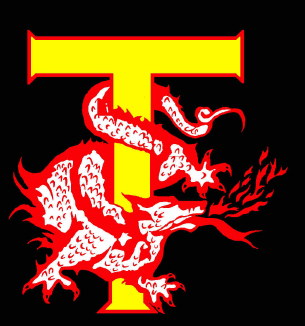
























| |
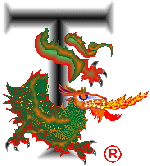 KENPO FREQUENTLY ASKED QUESTIONS KENPO FREQUENTLY ASKED QUESTIONS
If you don't see the "T and Dragon" it's not
Original, Traditional Kenpo.
For over 40 years people who never studied Kenpo, and more recently, those
who studied American Kenpo, which by its founder Ed Parker's own admission, is only about
10% Kenpo, have set themselves up as authorities on the history, origin and
traditions of Kenpo. They are, however, only authorities on Kenpo guano.
We have
no intention of putting down either pen or sword until we have obliterated every
false redaction of Kenpo history and refuted the absurd claims about its origin,
founders and practitioners. These FAQs (as well as the other pages on this site)
are NOT intended to set Tracy's up as the "best system" of any martial
art. Nor are they intended to show that any martial arts system is not good.
While "best" and "not good" are concepts of many American
Kenpo stylists, they are contrary to Tracy philosophy and practice.
Share
Portions of this article ©1996-1999 by
Al
Tracy & Will Tracy.
All rights reserved. No portion may be reproduced without permission.

IMPORTANT NOTE: Be sure to hit
your web browser's "refresh" button (F5 key in Windows or on a
Mac) to view the most current version of each page
|
|
Check back regularly for more frequently asked questions.
Last Updated 03/03/10

 A. The first black belt "rank" is Shodan, which means literally, the "lowest rank".
From this it should be obvious that one can only be "ranked" by those who are themselves ranked higher.
In Kenpo, the Yudansha (those who hold a Dan rank) who are senior and higher ranked are the only ones who can give a Shodan rank.
The "Dan" rank is like that of the military. Only the military can give rank to its
members; so likewise, only the Dans of Kenpo can award Shodan or higher Dan
ranks, and a person who is of a Dan rank cannot award a rank higher than
the rank they themselves hold. There is no actual "rank"
of "black belt". There are only Dan
ranks. The belt color itself is meaningless without an
associated Dan ranking
system.
A. The first black belt "rank" is Shodan, which means literally, the "lowest rank".
From this it should be obvious that one can only be "ranked" by those who are themselves ranked higher.
In Kenpo, the Yudansha (those who hold a Dan rank) who are senior and higher ranked are the only ones who can give a Shodan rank.
The "Dan" rank is like that of the military. Only the military can give rank to its
members; so likewise, only the Dans of Kenpo can award Shodan or higher Dan
ranks, and a person who is of a Dan rank cannot award a rank higher than
the rank they themselves hold. There is no actual "rank"
of "black belt". There are only Dan
ranks. The belt color itself is meaningless without an
associated Dan ranking
system.

A. Kenpo is a Japanese word for a martial art that has its roots in China.
The system is, however, uniquely Japanese and Okinawan with a tradition going back to the 13th century.
The Gi and belts are, therefore, part of the tradition of Kenpo heritage and quite appropriate.
The belt, however, is always crossed in the back and tied in the front with an overhand square knot.
The more recent creations of Kenpo styles, such as Kara-Ho Kempo, Shaolin Kenpo, American Kenpo and the other systems all claim to be Chinese.
Yet those systems not only wear the Japanese Gi, but use the Tracy Colored Belt System for white belt ranks and the Japanese Belt System of Brown and Black Belts.
To this, many add tips on the belts, that have no meaning. There is only one reasonable answer for why a Chinese system does not wear Chinese Kung Fu uniforms and sashes:
It's easier to "sell" belts and tips than give knowledge and develop
actual ability.

A. Because they are either ignorant, or disrespectful, of Japanese culture.
The Gi, like the Kimono, should always be worn in traditional Japanese fashion by both men and women.
That is, the left lapel of the Gi always crosses on top of the
right. The only exception to this rule is when the person is dead.
Then the Gi is crossed right over the left. And we would certainly hope that instructors have more confidence in their ability to teach, than to allow their students to dress for their own funeral.
The problem is, too many Kenpo and other martial arts instructors do not know the history or traditions of
Kenpo or their martial art, and many are so arrogant as to presume to change custom through their ignorance.
They have learned moves without gaining the heart of Kenpo or the martial
arts. They have turned the art into an American system that has lost the "Soul of
Kenpo" and the martial arts.

A. The Karate (Judo) belt is exclusively Japanese and there is only one proper way to wear it, that is, according to Japanese tradition.
The belt is wrapped around the waist twice; and is always crossed in the back with what will be the right end crossing on the top; the belt is tied in the front with the left end going behind both layers of the belt; it is always tied in a square knot, so the left end hangs on the left side and the right end hangs on the right side.
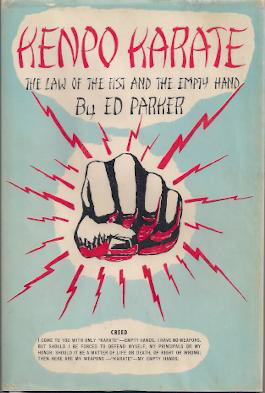 Ed Parker published Kenpo Karate, the Law of the Fist and the Empty Hand in 1960, and showed the proper way to wear the belt on page 17.
The following year, Ed Parker began changing his system to make it more
"Chinese", and published Secrets of Chinese Karate in 1963.
That book has no pictures, but only drawings. Some drawings show the people wearing
Gi bottoms and T-shirts, but no belts. At page 239, Ed Parker gives a fanciful explanation of how the sash is worn in Kung
Fu that is, for the most part, his imagination.
Ed Parker published Kenpo Karate, the Law of the Fist and the Empty Hand in 1960, and showed the proper way to wear the belt on page 17.
The following year, Ed Parker began changing his system to make it more
"Chinese", and published Secrets of Chinese Karate in 1963.
That book has no pictures, but only drawings. Some drawings show the people wearing
Gi bottoms and T-shirts, but no belts. At page 239, Ed Parker gives a fanciful explanation of how the sash is worn in Kung
Fu that is, for the most part, his imagination.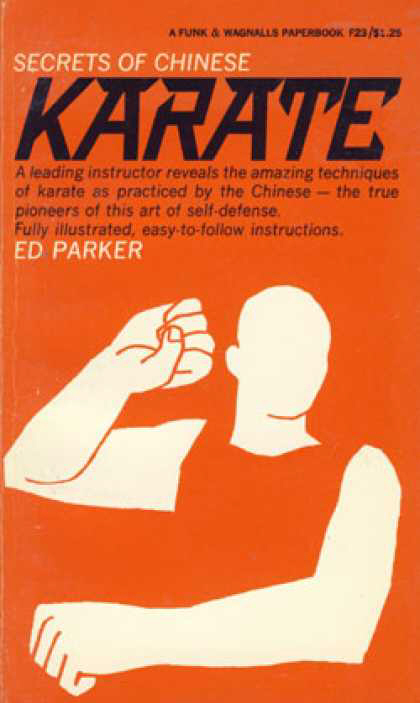
NOTE: "Chinese Kenpo" is a term coined by Ed Parker in 1960, when he found there was no kung fu style that resembled Kenpo.
But adding Chinese forms and Chinese terms did not change the nature or Japanese origin of Kenpo.
It has, however, imbued the "Chinese connection" with an "ignorance is bliss" mentality.
One of Ed Parker's students at the time was Jerry Meyers, who went on to train with Bruce Lee and Danny Inosanto, and combined their style with Kenpo to make it a true Chinese Kenpo style.
The Chinese wear a sash which is worn on either the right or left side by both men and women, according to ones position in the class.
However, Ed Parker did not follow Chinese tradition in changing the way the belt was to be worn in his schools.
He took the positioning of the knot directly from Mormon Temple Ceremony, and told his close Mormon friends,
including the Tracy Brothers, when his students became Mormons, "they would realize the profound spiritual meaning of his system."
That is why Ed Parker began wearing his belt so it did not cross in the back.
He made his higher ranking belts on a par with the Mormon priesthood, and they, like the Mormons who went through the temple, would wear their belt the same way as the higher priesthood wore their sash in the temple.
Women, according to Mormon doctrine, cannot hold the "priesthood," and therefore Ed Parker required them to wear their belt on the opposite side.
He would later justify this as being Hawaiian tradition, where the woman wears the flower on the right side of her head.
That, of course, is only true when the woman is "available". If she is not available she wears the flower on the left side.
Tracy's rejected all of Ed Parkers changes to the system, first because they saw no reason to change tradition, secondly, because most were subliminal attempts to impose Mormon doctrines on students, and thirdly, because the changes were mostly sexist and
racist.
Just how far Ed Parker's Mormon influences ran came to light at his funeral, when many who attended thought he was buried in a
Gi. They did not realize he was actually buried in his Mormon Temple garments.

 A. The dragon is both Chinese and Japanese, and has a universal symbolism, however, it is used to depict the Tracy System, and the emblem is not a Tracy
Mon. The "T" is, of course, purely Western, and symbolizes the bridge between the Kenpo of Japanese antiquity and the Tracy system.
The Tracy Family, (Gouzoku) displays five Mons, three of which are
Kamon. All are worn traditionally in the "three places five places", and are only displayed in public on traditional Japanese garments, never on the
Gi. The three Kamon each depict the three-day moon (one of the first year, another of the seventh year, and another with of twenty-first year) and the plumb blossom of three sizes.
A. The dragon is both Chinese and Japanese, and has a universal symbolism, however, it is used to depict the Tracy System, and the emblem is not a Tracy
Mon. The "T" is, of course, purely Western, and symbolizes the bridge between the Kenpo of Japanese antiquity and the Tracy system.
The Tracy Family, (Gouzoku) displays five Mons, three of which are
Kamon. All are worn traditionally in the "three places five places", and are only displayed in public on traditional Japanese garments, never on the
Gi. The three Kamon each depict the three-day moon (one of the first year, another of the seventh year, and another with of twenty-first year) and the plumb blossom of three sizes.
As for the so-called "Kosho Shorei Ryu Mon," it is neither traditional nor Japanese, but appears to be more Okinawan, and is not used by Tracy's because it has no relevance in Traditional Kenpo.

A. Many of those who claim to be authorities on Kenpo weren't there in the beginning and simply don't know.
There are well over 700 Kenpo techniques, and many of Professor Chow's Shodan as well as Tracy's require between 400-500 techniques for Shodan.
 Unlike those in American Kenpo, the Tracy brothers were with Ed Parker in 1960 when he wrote
Kenpo Karate,
The Law Of The Fist And The Empty Hand (Iron Man Industries).
The book illustrates the basic moves of Kenpo and 62 techniques. The book, which Ed Parker stated was "a book for novice practitioners"
(Infinite
Insights Into Kenpo, Mental Stimulation 1982), was used as a training manual for the White Belt First Brown Tip.
Unlike those in American Kenpo, the Tracy brothers were with Ed Parker in 1960 when he wrote
Kenpo Karate,
The Law Of The Fist And The Empty Hand (Iron Man Industries).
The book illustrates the basic moves of Kenpo and 62 techniques. The book, which Ed Parker stated was "a book for novice practitioners"
(Infinite
Insights Into Kenpo, Mental Stimulation 1982), was used as a training manual for the White Belt First Brown Tip.
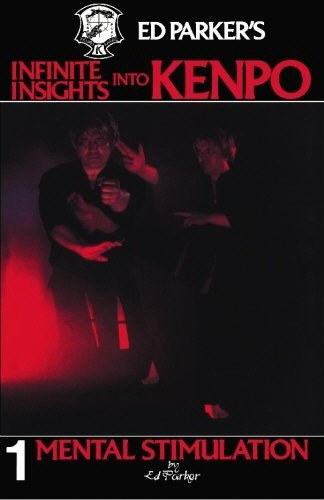 There were only two brown tips before Brown Belt in 1960, Gokyu (5th kyu) and
Shikyu (4th kyu) and Rokukyu (6th kyu) was the grade of a beginner.
Shikyu as well as the three degrees of Brown Belt Sankyu, Nikyu and Ikkyu each required an additional 80 techniques.
Shodan (which was the highest rank in Kenpo at the time) required an additional 120 techniques.
That was a total of 502 Kenpo techniques and variations required for Shodan in 1960.
In addition to the Kenpo techniques, there were also over 300 Jiu-Jitsu techniques required for Shodan, and there were nearly 300 more Kenpo techniques in the system that were being taught to Shodans.
Just prior to the publication of this book, Ed Parker reduced the number of Jui Jitsu techniques to less than 50, and by 1961,
he had eliminated them completely from his system. There were only two brown tips before Brown Belt in 1960, Gokyu (5th kyu) and
Shikyu (4th kyu) and Rokukyu (6th kyu) was the grade of a beginner.
Shikyu as well as the three degrees of Brown Belt Sankyu, Nikyu and Ikkyu each required an additional 80 techniques.
Shodan (which was the highest rank in Kenpo at the time) required an additional 120 techniques.
That was a total of 502 Kenpo techniques and variations required for Shodan in 1960.
In addition to the Kenpo techniques, there were also over 300 Jiu-Jitsu techniques required for Shodan, and there were nearly 300 more Kenpo techniques in the system that were being taught to Shodans.
Just prior to the publication of this book, Ed Parker reduced the number of Jui Jitsu techniques to less than 50, and by 1961,
he had eliminated them completely from his system.
When the Tracy brothers added Hachikyu (Yellow Belt) as the first earned belt in Kenpo, and made
Kukyu (9th kyu) the unearned belt, the rest of Kenpo adopted the Tracy Colored Belt System.
It was about this time that the number of required techniques for each belt was changed to 32, and later to
30 techniques. About the same time, Ed Parker removed all variations (which he renamed extensions) from his belt requirements and cut the techniques he was teaching in half; the first half being taught for the belts below brown, and the second half being taught for brown belt, and then for black
belt. Professor Chow and the Tracy brothers continued with Kenpo, and its original techniques, while Ed Parker changed his system to American Kenpo, which, by Ed Parker's own admission, is no more than 10% Kenpo.

A. The short answer is: Kenpo is spelled with an
N, but pronounced as an M, as in KeMpo.
"Kenpo", while spelled with an N, is pronounced Kempo (with an M); and either
Kenpo or Kempo has become acceptable. The general rule for Japanese to English translation is, when N is followed by P, the N is pronounced M.
There are some who claim the spelling was changed from Kenpo to Kempo by one master or another.
This is true. Some instructors wanted to distinguish their style from Kenpo, and some changed from Kempo to Kenpo when they learned what the more acceptable spelling was.
Often, however, Mitose's students spelled Kenpo as Kempo, because that's the way
it sounded.
A more in-depth answer will be posted soon. The
long answer is so comprehensive, that it will need it's own separate page.

A. Chun Fa is often expressed as an epitaph for
Kung Fu, meaning "flowery hands" (Fa being flower and Chun
representing a "set of hands").
About 700 years ago, several systems of kung fu, or chun fa, were taken to Okinawa and Japan.
However, there is not one shred of credible evidence to indicate that any of those styles was actually called Chun Fa.
To the contrary, Chun Fa appears not to have referred to a particular style, but like, "kung fu," was a general term that refers to many related "styles" of martial arts, and is synonymous with Chinese martial arts.
In that respect, every Chinese Martial Arts system could be called kung fu, or chun
fa.
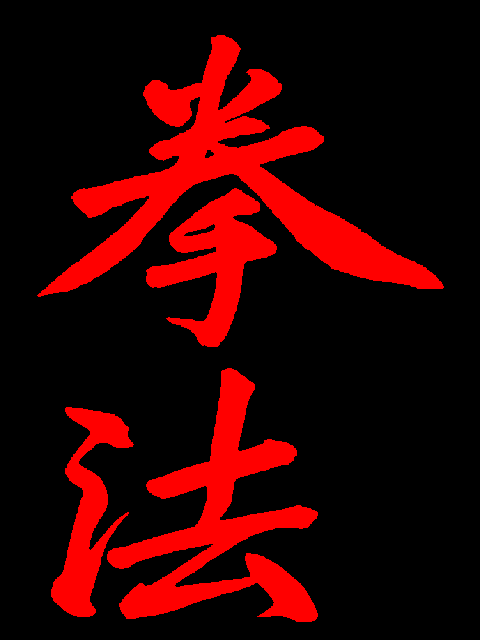 One of the styles that was brought to Okinawa and Japan became known as
Kenpo in the Japanese language and was given its own
Kanji characters. In China, the style from which Kenpo was derived either underwent massive changes, or it was lost over the centuries, as there is no system of kung fu, or chun fa on Mainland China that closely resembles Kenpo.
There are similarities in some of the moves of Kenpo and some kung fu styles, but there are far more differences than similarities. One of the styles that was brought to Okinawa and Japan became known as
Kenpo in the Japanese language and was given its own
Kanji characters. In China, the style from which Kenpo was derived either underwent massive changes, or it was lost over the centuries, as there is no system of kung fu, or chun fa on Mainland China that closely resembles Kenpo.
There are similarities in some of the moves of Kenpo and some kung fu styles, but there are far more differences than similarities.
In the general history of Kenpo, it is not incorrect to say that
Kenpo came from Chun Fa.
But to say that Chun Fa and Kenpo are the same is not only misplaced, but highly inaccurate.
The problem is, those who claim Kenpo is Chun-Fa seek to create a "Chinese Connection" that would make Kenpo the "Mother of all Kung Fu."
That connection does not exist. Kenpo was only one of many Chinese systems of kung fu, or chun fa.
It was never "the" original system of chun fa. In fact it is unlikely that there was ever "one" original system.
A good analogy would be in languages. English, German, French, Spanish, Italian, Greek, Persian and the Hindu languages are all part of the Indo-European (Aryan) language group.
They all have some similarities, but it would be ridiculous to claim that these languages are the same, or, except in their root, that they are even similar to each other.
And it would be as absurd to claim that English is "the" original Aryan language, as it is to claim that Kenpo is "the" original system of Chun Fa.

A. Professor Chow's system was and is called Kara-Ho Chinese Karate.
It was not his "original system," nor is it much like his Original Kenpo.
Rather, Kara Ho was created by Chow after 1984. (Professor Chow died in September 1987.)
Prior to his death, Kara Ho Chinese Karate, had no forms or weapon sets.
After his death, some of his students added their own forms and sets, as well as their own moves to what they continue to call Kara Ho Kempo.
However, Professor Chow's club/association was, and still is called the, "Hawaii Go Shinjutsu Kai, of Kara-Ho Chinese Karate".
Professor Chow never had a school or studio. He taught out of YMCAs, cultural halls and in parks.
Wherever Professor Chow taught, he taught from the heart. No student was ever turned away simply for lack of money.
Professor Chow never made a living from teaching Kenpo. He was the life of Kenpo.
And this cannot be emphasized enough. It was Professor Chow, not Ed Parker, who created Kenpo as it came to be known through Ed Parker's early students.
In the 1970s Professor Chow expanded on the fabrication of Ed Parker, that Chow had studied kung fu from his father, uncle and grandfather, and with Ralph Castro developed what would be called Shaolin Kenpo.
This was a completely new "Chinese" system, one that was not American Kenpo and one that Ed Parker had never learned.
By 1984, there were so many different "systems" of Shaolin Kenpo that Professor Chow tried to disassociate himself with all but Ralph Castro, and began developing what he believed would be his own unique system.
He called this Kara Ho Chinese Karate. "Kara" (meaning the Tang Chinese Dynasty) "Ho" (the whole spirit of the martial arts) and Chinese Karate is self explanatory.
"Kempo" which is used by many of Chow's followers is said to be Professor Chow's spelling.
Kara-Ho Chinese Karate should rightfully be a tribute to the genius of Professor Chow, who was too modest to take credit for the singleness-handed development of this new system.
Instead he gave credit to his ancestors who in reality contributed only inspiration to his new style.

A. Because we deal with fact, not fantasy.
Sun Chow Hoon was Professor Chow's father. He was never a Buddhist Monk and he never studied or taught kung fu or any other martial arts.
Hoon Chow married at the age of 12 and had two daughters before he was 16.
He converted to Mormonism when he was 18 and immigrated to the United States when he was 19, leaving his family in China.
He took a second wife in Hawaii, and "Willie" (Professor Chow) was his first born son in America.
There was a very accurate description of Hoon Chow's fighting technique, when he was involved in a barroom fight for which he was arrested and sentenced to 10 month is prison.
From that record it was quite obvious that Hoon Chow did not know kung fu.
Here are the facts (coming soon).

A. Both Thomas Young and "Willie" Chow began training in Kenpo
Jiu-jitsu under James Mitose at the "Official Self-Defense Club" on Oahu when it was organized during WWII.
Chow and Mitose had been close friends for some time, and Chow even lived with Mitose for a time during WWII.
He was not Mitose's house boy as some have claimed. However, by 1946, a family matter had caused a riff between the two men.
In 1946 Mitose promoted Thomas Young to Shodan and then as a slap in the face to Chow, promoted Young to Assistant Instructor.
Kenpo did not have the belt system it has today, and Shodan was the only "dan" rank.
The ranks after Shodan were Assistant Instructor, Instructor, Master, Head Master, Grand Master and Great Grand Master.
When Chow was promoted to Shodan a few weeks later, Mitose refused to sign Chow's certificate, and Thomas Young signed it as Chow's instructor.
Men of less character would have acted very differently.
But Mitose promoted Chow to Assistant Instructor, equal to Thomas Young, and Chow continued to train under Mitose for another two and a half years.
After being promoted to Instructor, Chow opened his own club in the spring of 1949 where he taught what he called Kenpo Karate.
According to Lisa Chung-Edwards, who studied with Mitose during this period (her picture is in Mitose's book and she is now with Tracy's), Mitose's school never had more than 20 students at one time.
Mitose did all of the teaching, and Chow and Young assisted in the class, and they taught small groups at the YMCA and cultural halls for Mitose.
Several people interviewed Mitose, Chow and Young throughout the years, and Mitose always said Chow was his student.
Thomas Young never claimed Chow was his student, but rather stated many times that he and Chow studied with Mitose together; and, of course, Chow always claimed Mitose as his instructor.
Grand Master Fusae Oshita who was senior to both Young and Chow, stated emphatically that Mitose was Chow's instructor.
That does not exactly make Professor Chow the student of Thomas Young.
Of course if anyone wants to believe Thomas Young was Chow's instructor, that would make Chow
the greatest Kenpo Master in the history of the art.
After all, it took Thomas Young 4 years to make Shodan, whereas, his "student", Chow made not only Shodan but Assistant Instructor in just a matter of weeks.
It is far more reasonable to accept what those who were there said, than it is to believe those who pretend to know the "truth."

A. There are actually only 5 recognized Kenpo Associations at this time, Ralph
Castro's Shaolin Kenpo, Tracy's Kenpo Karate, John McSweeney's American Kenpo Karate
Association (White Tiger Kenpo), Professor Chow's Hawaii Go Shinjutsu Kai of Kara-Ho Chinese Karate, and Ed
Parker's International Kenpo Karate Association, which, since the death of Ed Parker is generally no longer recognized as an actual "Kenpo" association.
With the exception of the IKKA, each of these organizations represents a distinct system of Kenpo.
Kajukembo, while having its roots in Kenpo, and is therefore
a related art, is the masterful creation of Adriano Emperado, and
unique to the point of being considered its own style, and is therefore no longer Kenpo.
Kajukembo has its own Associations separate from all Kenpo systems.
A brief breakdown of the
Kenpo organizations is soon to come, so check back here in the future.

A. You and the others who spell Yuudansha, "Yudansha," demonstrate the term's true meaning.
Yuudansha is very old, going back to the Chinese and means, literally, "an association of negligence or remissness."
Yuudanshai on the other hand, means a fraternal "Dan" association.
That is, those who have received their rank from the society or fraternal order of the Dans, i.e., the Yuudanshai.
The first IKKA certificates
had the incorrect spelling, which only the Yuudansha noticed. When new IKKA certificates were printed a few years later, the Yuudanshai Kokusai demanded reference to their association be omitted.
Anyone can wear a black belt and anyone can claim to be a black belt.
However, a black belt does not mean one has earned a "Dan" ranking, and such a person is not a Yuudansha, as those who are not Yuudansha would like to believe.
A Yuudansha is only recognized when he or she has received Shodan from one who belongs to a Yuudanshai organization.

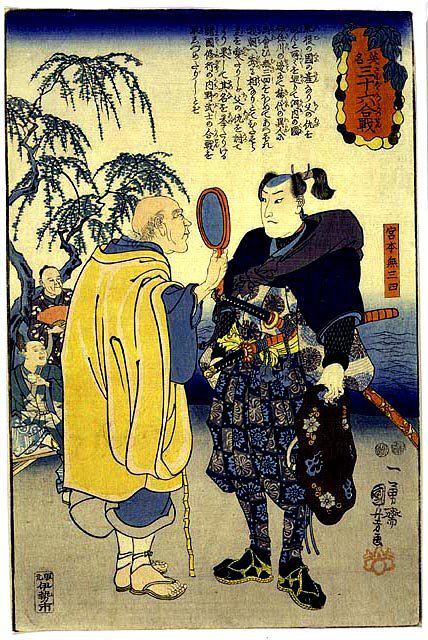 A. A
Ronin (浪人),
or rounin, was originally a masterless Samurai, that is a Samurai of a dead Lord.
More recently the term has come to mean someone who is waiting for a second chance.
Likewise, when a student fails the entrance exam for the Japanese higher education system, he is referred to as a
Rouninsai. Many wealthy Japanese send their rouninsai to the United States to attend College.
When they return to Japan, they are ronin. A. A
Ronin (浪人),
or rounin, was originally a masterless Samurai, that is a Samurai of a dead Lord.
More recently the term has come to mean someone who is waiting for a second chance.
Likewise, when a student fails the entrance exam for the Japanese higher education system, he is referred to as a
Rouninsai. Many wealthy Japanese send their rouninsai to the United States to attend College.
When they return to Japan, they are ronin.
Ed Parker became the head, or master, of his own Kenpo Gouzoku, or "Powerful Family" in the late
1960's. However, Ed Parker was very careful with whom he established in his Kenpo Family.
By the time he died in December 1990, those who had been his niban (number two) had either been given their own Gouzoku, or had died, or had been adopted into his Kenpo Family and their ascension was in question, so there was no one to take his position.
Ed Parker had promoted many black belts, but none of these did he admit to his Kenpo Family.
When Ed Parker died, all of his Black Belts were left masterless; and, because they were never admitted to the Ed Parker Gouzoku none could take his place as the head of his family.
Not only weren't these black belts ever admitted to the Ed Parker Gouzoku, they have, for the most part, all disassociated themselves from his family.
They can never become the head of the Parker Kenpo Family, or of their own Gouzoku, for that matter.
Being masterless, they claim to be "masters". They are, however,
Ronin.

A. Kenpoka is a pseudo Japanese word which looks authentic because a
Karateka is a practitioner of Karate, and therefore a Kenpoka would, to the uneducated, be a practitioner of Kenpo.
While the word for a practitioner of Kenpo is somewhat similar, it is, nevertheless, spelled and pronounced differently.
There are many uneducated people who claim to be authorities on Kenpo, but who know little more than what they have read.
We have found that many of these wannabe authorities criticize Tracy's while taking what we write and claim it as their own.
We use the word "Kenpoka" in several places on the site, simply to have fun with those who see the word, then call themselves Kenpoka.
We also have the word spelled correctly on the site. However, since there are at least five people on the web with user names of Kenpoka, who criticize Tracy's, they are the ones for whom we coined the word.
-

-
back
to the Tracy Martial Arts System Home Page
Portions of this article ©1996-1999 by Al
Tracy & Will Tracy.
All rights reserved. No portion may be reproduced without permission.
|
|
